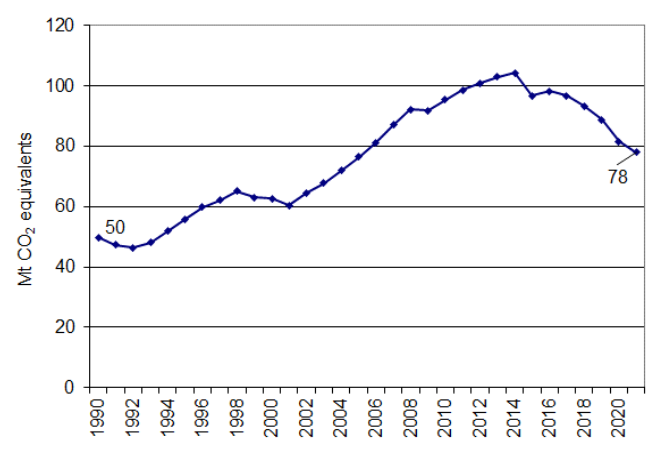While most EU economic sectors saw emission increases in 2021, HFC emissions decreased
The EU National Inventory Report (NIR) for GHG emissions, published on the UNFCCC website, shows that total GHG emissions (including Land Use, Land Use Change and Forestry, or LULUCF, and international aviation) increased in 2021 by 193 million tonnes, or 6.2%, compared to 2020, to reach 3,311 million tonnes CO2 equivalent in 2021. In contrast, HFC emissions decreased by 3 million tonnes CO2 equivalent, or 4.3%, compared to 2020. The increase in GHG emissions in 2021 was the largest in absolute and relative terms year-on-year in the EU since 1990. This can be attributed to the economic recovery, underpinned by higher coal use in the power sector and transport demand that followed the strong contraction in economic activity during the COVID-19 pandemic of 2020. Almost all economic sectors saw significant emission increases in 2021, including manufacturing industries and construction, iron and steel, and international aviation, among others. The effects of the COVID-19 pandemic on HFC emissions are uncertain as HFC emissions decreased in 2021, which according to the NIR, “is due to the measures of the EU F-Gas Regulation, however, might also reflect impacts of the COVID-19 pandemic.”

NIR Figure 2.11 Fluorinated gas emissions 1990 to 2021 in CO2 equivalents (Mt, million tonnes) in 2021 HFCs are 70 Mt CO2e
According to the NIR, fluorinated gas emissions account for 2.1% of total EU GHG emissions (see explanatory note as 2.1% is the share for HFCs only). In 2021, emissions amounted to 78 million tonnes of CO2 equivalents, which was 57% above 1990 levels (Figure 2.11). Refrigeration and air conditioning, the largest key category, accounted for 82% of fluorinated gas emissions in 2021. The main reason for this is the phase-out of ozone-depleting substances such as chlorofluorocarbons under the Montreal Protocol and the replacement of these substances with HFCs (mainly in refrigeration, air conditioning, foam production and as aerosol propellants).
The NIR reports 2 categories for the emissions of F-Gases from fluorochemical production (Section 4.2.2.5) (i) unspecified mix of HFCs and (ii) unspecified mix of HFCs and PFCs. Total emissions from both categories combined (HFCs and PFCs) from fluorochemical production in the EU have reduced by 97.5% since 1990.
The March 2023 newsletter item on global and European HFC reported emissions compared to emissions derived from atmospheric monitoring explained that for Europe, top-down (atmospheric monitoring) HFC-134a emission estimates are significantly lower than the reported HFC-134a emissions. The top-down estimates of aggregated HFC-134a emissions for reporting countries in the domain were 51% (37–69%) lower than the reports to the United Nations Framework Convention on Climate Change (UNFCCC) (total top-down emissions were 18.6 (16.7–20.6) Gg yr–1 [18,600 tonnes] for this domain).
Explanatory Note: Total EU GHG emissions are reported as 3,311 MtCO2e. The NIR (Chapter 2) states F-Gas emissions account for 2.1% of total EU GHG emissions in 2021, at 78 Mt CO2 equivalents. But 78/3,311 = 2.4% (not 2.1%) and HFC emissions at 70 Mt CO2 equivalents is 70/3,311 = 2.1%. The shares for CH4 and N2O are correctly reported. The NIR states CH4 emissions account for 13% of total EU GHG emissions in 2021 at 415 Mt CO2 equivalents. 415/3,311 = 12.5% ie 13%. N2O emissions are responsible for 6% of total EU GHG emissions in 2021 at 186 Mt CO2 equivalents is 186/3,311= 5.6%.